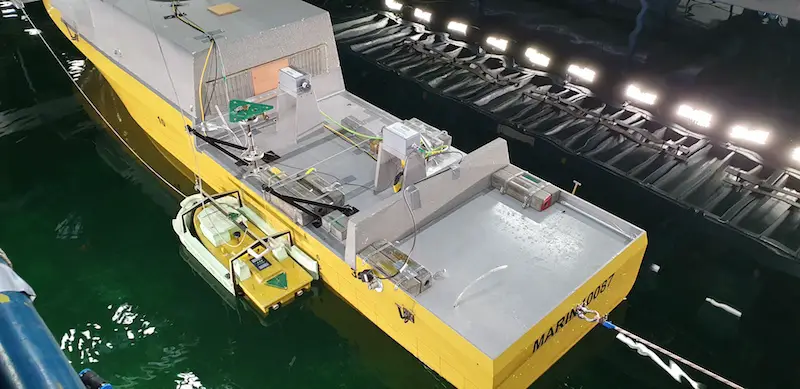In Naval Group’s Dutch partner MARIN facilities, Belgian and Dutch officials witnessed the 100% successful launching and recovery of USVs using Naval Group Launch and Recovery System (LARS). The tests were conducted up to sea state 5/6 (significant waves height: 4m) and with incoming waves from all directions (including leeward of the mothership).
This is a world first and proves that the launch and recovery concept developed by Naval Group is the answer for operating USVs safely in harsh maritime environments. Naval Group demonstrated its expertise and qualifies its system, paving the way to new capabilities for navies needing to operate USV at sea in difficult conditions.
Naval Group mothership has one port and one starboard LARS located slightly aft of midship, close to the ship’s centre of gravity. Each LARS consists of a pivoting A-Frame davit with the USV, weighing up to 18t, housed in a floating cradle. It allows the simultaneous launch of two USVs with maximal safety. For the Belgian-Dutch mine countermeasure (MCM) program, conducted by Belgium Naval Robotics – a Naval Group and ECA Group consortium -, they will be used to operate two ECA’s Inspector 125 USV.
Claude Bultot, the Belgian program director said “This success is an important milestone in the program and towards the implementation of a new way to conduct our minehunting activities that will be more efficient and safer for our crews. We are looking forward to the next steps together with the Dutch navy and with our industrial partners from Naval Group and ECA Group.”
These tests belong to a series for the MCM BE/NL program. In August 2019, first tank tests were carried out in MARIN facilities with the same scale model of the ship’s hull and propulsion system under calm sea conditions. The first objective was to confirm and fine-tune computational fluid dynamic predictions made for speed and to validate the overall hull drag and propellers efficiency. The second objective was to assess interactions between the hull and propulsion system in order to estimate the total propulsion power of the ship. The next series of tests will take place in February and will assess the cradle handling dynamic aspects.
The contract for twelve minehunters for the Belgian and Dutch navies will run over ten years. After a three-year design period, Belgium Naval & Robotics will move into the production phase for these ships and drone systems, with a first delivery due in 2024. Six ships will be delivered to the Belgian navy and six to the Dutch navy; all are equipped with complete drone systems (toolboxes) in total containing over a hundred underwater, surface and aerial drones fully dedicated to mines countermeasures.
















